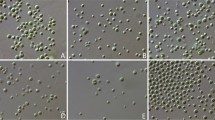Abstract
A morphological account on the endosymbiosis between Amphiscolops sp and Amphidinium sp is given, based on scanning and transmission electron microscopy observations. The algal symbionts (15–20 µm in diameter) are found among cells of the peripheral parenchyma. Amphidinium sp. has a single pyrenoid of the multiple-stalked type, with several chloroplast lobes radiating from it. A comparison with A. klebsii is made. Our observations reinforce the assumption of selectivity of Amphiscolops for the symbiotic genus Amphidinium.
Similar content being viewed by others
References
Anderson, O. R., 1983. Radiolaria. Springer-Verlag, New York, 355 pp.
Antonius, A., 1968. Faunistische Studien am Roten Meer im Winter 1961/62, Teil IV. Neue Convolutidae and eine Bearbeitung des Verwandtschafts-kreises Convoluta (Turbellaria Acoela). Zool. Jb. Syst. Bd 95: 297–394.
Dodge, J. D. & R. M. Crawford, 1968. Fine structure of the dinoflagellate Amphidinum carteri Hulbert. Prostilogica 4: 231–242.
Dodge, J. D. & R. M. Crawford, 1971. A fine structural survey of dinoflagellate pyrenoids and food-reserves. Bot. J. linn. Soc. 64: 105–115.
Dodge, J. D. & C. Greuet, 1986. Dinoflagellate ultrastructure and complex organelles. In F.J.R. Taylor (ed.), The biology of Dinoflagellates. Blackwell Sc. Publ. Oxford: 92–141.
Douglas, A. E. (in litt.). John Innes Institute, Colney Lane, Norwich NR4 7UH, U.K.
Douglas, A. E., 1983(a). Establishment of the symbiosis in Convoluta roscoffensis. J. mar. biol. Ass. U.K. 63: 419–434.
Douglas, A. E., 1983(b). Uric acid utilization in Platymonas convolutae and symbiotic Convoluta roscoffensis. J. mar. biol. Ass. U.K. 63: 435–447.
Douglas, A. E., 1985. Growth and reproduction of Convoluta roscoffensis containing different naturally occurring algal symbionts. J. mar. biol. Ass. U.K. 65: 871–879.
Douglas, A. E., 1988. Alga-invertebrate symbiosis. In: Rogers, L. J. & J. R. Gallon (eds), Biochemistry of the Algae and Cyanobacteria. Oxford Sci. Publ., Oxford: 297–309.
Douglas, A. E. & G. W. Gooday, 1982. The behaviour of algal cells towards egg capsules of Convoluta roscoffensis and its role in the persistence of the Convoluta-alga symbiosis. Br. phycol. J. 17: 383–388.
Fenchel, T., 1987. Ecology of Protozoa. Science Tech. Publ., Madison, Springer-Verlag, Berlin, 197 pp.
Gaeta, S. A., D. S. Abe, S. M. Susini, R. M. Lopes & P. M. Metzler, 1990. Produtividade primaria, plâncton e covariáveis ambientais no canal de São Sebastião durante o outono. Rev. Brasil. Biol. 50: 963–974.
Kofoid, C. A. & O. Swezy, 1921. The free-living unarmored dinoflagellates. Mem. Univ. Calif. 5: 1–562.
Lopes, R. M. Zooplankton composition and distribution in the Guaraiú River estuary (São Paulo State, Brazil). Estuar Coast Shelf Sci.
Lopes, R. M., M. S. Almeida Prado Por & F. D. Por, 1986. Zooplankton seasonality in the Rio Verde estuary (Juréia, São Paulo, Brazil). Rev. Hydrobiol. trop. 19: 207–214.
Marcus, E., 1950. Turbellaria Brasileiros (8). Bolm. Fac. Fil. Ciênc. Let. (São Paulo) 15: 5–141.
Markell, D. A., R. K. Trench & R. 1. Prieto, 1992. Macromolecules associated with the cell walls of symbiotic dinoflagellates. Symbiosis 12: 19–31.
Michaels, A. F., 1988. Vertical distribution and abundance of Acantharia and their symbionts. J. mar. biol. 97: 559–569.
Muscatine, L., F. P. Wilkerson, L. R. McCloskey, 1986. Regulation of population density of symbiotic algae in a tropical marine jellyfish (Mastigias sp). Mar. Ecol. Prog. Ser. 32: 279–290.
Namimatsu, S., 1992. Periodic acid thiosemicarbazide gelatin methenamine silver (PATSC-GMS) staining for transmission electron microscopy. J. submicrosc. Cytol. Pathol. 24: 19–28.
Por, F. D., M. S. Almeida Prado Por & E. C. Oliveira, 1984. The mangal of the estuary and lagoon system of Can anéia (Brazil). In F. D. Por & I. Dor (eds), Hydrobiology of the Mangal. Dr W. Junk Publishers, The Hague: 211–228.
Provasoli, L., T. Yamasu & I. Manton, 1968. Experiments on the resynthesis of symbiosis in Convoluta roscoffensis with different flagellate cultures. J. Mar. Biol. Ass. U.K. 48: 465–479.
Rohde, K. N. Watson & L. R. G. Cannon, 1988. Ultrastructure of epidermal cilia of Pseudactinoposthia sp. (Platyhelminthes, Acoela); implications for the phylogenetic status of the Xenoturbellida and Acoelomorpha. J. submicrosc. Cytol. Pathol. 20: 759–767.
Soyer, M. O. & O. K. Haapala, 1974. Structural changes of Dinoflagellate chromosomes by pronase and ribonuclease. Chromosoma (Berl.) 47: 179–192.
Soyer-Gobillard, M. O. & M. L. Geraud, 1992. Nucleolus behaviour during the cell cycle of a primitive dinoflagellate eukaryote, Prorocentrum micans Ehr., seen by light microscopy and electron microscopy. J. Cell Sci. 102: 475–485.
Spero, H. J. & S. L. Parker, 1985. Photosynthes in the symbiotic planktonic foraminifer Orbulina universa, and its potential contribution to oceanic primary productivity. J. Foram. Res. 15: 273–281.
Stoecker, D. K., 1991. Mixotrophy in marine planktonic ciliates: physiological and ecological aspects of plastidretention by gligotrichs. In P. C. Reid, C. M. Turley & H. Burkill (eds), Protozoa and their role in marine process. Springer, Berlin: 161–179.
Stoecker, D. K., N. Swamberg & S. Tyler, 1989. Oceanic mixotrophic flatworms. Mar. Ecol. Progr. Ser. 58: 41–51.
Swamberg, N. R., 1983. The trophic role of colonial Radiolaria in oligotrophic oceanic environments. Limnol. Oceanogr. 28: 55–666.
Taylor, D. L., 1971. On the symbiosis between Amphidinium klebsii (dinophyceae) and Amphiscolops langheransi (Turbellaria: Acoela). J. mar. biol. Ass. U.K. 51: 301–313.
Taylor, F. J. R., 1982. Symbiosis in marine microplankton. Ann. Inst. Oceanogr. Paris 58: 61–90.
Thiéry, J. P., 1967. Mise en évidence des polysaccharides sur coupes fines en microcopie électronique. J. Microscopie 6: 987–1018.
Trench, R. K., 1986. Dinoflagellares in non-parasitic symbioses. In F. J. R. Taylor (ed.), The biology of Dinoflagellates. Blackwell Sc. Publ. Oxford: 530–561.
Trench, R. K. & H. Winsor, 1987. Symbiosis with dinoflagellates in two pelagic flatworms, Amphiscolops sp. and Haplodiscus sp..Symbiosis 3: 1–22.
Tyler, S., 1979. Distinctive features of cilia in metazoans and their significance for systematics. Tissue & Cell 11: 385–400.
Author information
Authors and Affiliations
Rights and permissions
About this article
Cite this article
Lopes, R.M., Silveira, M. Symbiosis between a pelagic flatworm and a dinoflagellate from a tropical area: structural observations. Hydrobiologia 287, 277–284 (1994). https://doi.org/10.1007/BF00006376
Received:
Revised:
Accepted:
Issue Date:
DOI: https://doi.org/10.1007/BF00006376




